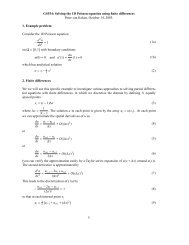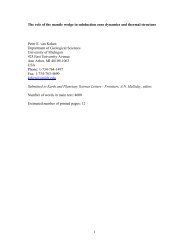Quantitative paleoenvironmental and paleoclimatic reconstruction ...
Quantitative paleoenvironmental and paleoclimatic reconstruction ...
Quantitative paleoenvironmental and paleoclimatic reconstruction ...
Create successful ePaper yourself
Turn your PDF publications into a flip-book with our unique Google optimized e-Paper software.
ARTICLE IN PRESS<br />
N.D. Sheldon, N.J. Tabor / Earth-Science Reviews xxx (2009) xxx–xxx<br />
25<br />
Mineral-CO 2 carbon isotope fractionation values (10 3 ln 13 α; Table 5;<br />
Fig. 21) forcalcite(Bottinga, 1968) <strong>and</strong>theFe(CO 3 )OH group in solid<br />
solution with goethite (Yapp <strong>and</strong> Poths,1993) are positive, indicating that<br />
13 C is enriched in the mineral product, whereas mineral-bound C that is<br />
apparently in solid solution with gibbsite (Tabor <strong>and</strong> Yapp, 2005a,b)<br />
shows no fractionation with respect to gaseous CO 2 (i.e., gibbsite <strong>and</strong> CO 2<br />
δ 13 C values are equivalent; Schroeder <strong>and</strong> Melear, 1999). Calcite-CO 2<br />
10 3 ln 13 α values decrease with increasing temperature (Fig. 14A),<br />
whereas goethite-CO 2 <strong>and</strong> gibbsite-CO 2 10 3 ln 13 α values do not exhibit<br />
temperature dependence (Yapp, 2001a,b). Although siderite-CO 2<br />
10 3 ln 13 α values appear to follow closely those for calcite-CO 2 , siderite-<br />
CO 2 10 3 ln 13 α values are too poorly studied at this time to be expressed as<br />
a temperature-dependent fractionation equation (see Fig. 14C).<br />
7.1.3. Relationship between hydrogen <strong>and</strong> oxygen isotopes in continental<br />
waters<br />
The vast majority of continental surface waters are meteoric in<br />
origin (Dansgaard, 1964; Gat <strong>and</strong> Bowser, 1991). That is, surface<br />
waters are derived from the atmosphere as precipitation (rainfall <strong>and</strong><br />
snow). The main source of meteoric water is vapor derived from<br />
evaporation of ocean water, which has maintained mean δ 18 O values<br />
near 0‰ (±2‰) for most of the Phanerozoic (Gregory, 1991; Yapp <strong>and</strong><br />
Poths, 1992; Tabor, 2007; Eiler, 2007). Over the continents, the oxygen<br />
<strong>and</strong> hydrogen isotope values of rainfall follow a Rayleigh-type<br />
distillation, whereby subsequent rain-out events have progressively<br />
more negative oxygen <strong>and</strong> hydrogen isotope values. The rain-out<br />
process is driven principally by cooling of the air-mass (Dansgaard,<br />
1964; Fig. 15), which may arise from vertical thermal uplift, physical<br />
transport over high-altitude sites (e.g., mountains), or latitudinal<br />
transport to cooler sites (e.g., Rozanski et al., 1993; Clark <strong>and</strong> Fritz,<br />
1997). The oxygen <strong>and</strong> hydrogen isotope values of rainfall are strongly<br />
correlated, <strong>and</strong> may be approximated by the equation for the meteoric<br />
water line (Craig, 1961): δD=8⁎δ 18 O+10. While there is abundant<br />
evidence for short-term departures from the meteoric water line (e.g.,<br />
Gat <strong>and</strong> Bowser, 1991; Krishnamurthy <strong>and</strong> Bhattacharya, 1991;<br />
Lawrence <strong>and</strong> White, 1991), the long-term weighted mean of<br />
precipitation δ 18 O <strong>and</strong> δD values indicates that the aforementioned<br />
equation for meteoric water is an accurate representation of isotopes<br />
in the meteoric water cycle. Considering that timescales for significant<br />
accumulation of authigenic minerals in soil profiles range from 10 3 –<br />
10 5 years, it is generally assumed that Craig's (1961) meteoric water<br />
line equation is an accurate representation of precipitation that rained<br />
upon, <strong>and</strong> percolated through, the soil profile (e.g., Yapp, 1993a,<br />
2001a,b; Delgado <strong>and</strong> Reyes, 1996; Ferguson et al., 1999; Savin <strong>and</strong><br />
Hsieh, 1998; Vitali et al., 2001; Tabor <strong>and</strong> Montañez, 2002, 2005; Tabor<br />
et al., 2002; Tabor, 2007; Gilg, 2003).<br />
In fact, both the δ 18 O<strong>and</strong>δD values of rainfall are correlated with<br />
surface air temperature (e.g., Fig. 15 — IAEA Database from Rozanski<br />
et al., 1993). Based upon previous studies of meteoric precipitation δ 18 O<br />
<strong>and</strong> δD values, Criss (1999; see also Dansgaard, 1964) arrived at the<br />
following correlation: δ 18 O MAP ≈0.695 MAT(°C) — 13.6, where MAP is the<br />
weighted mean annual precipitation <strong>and</strong> MAT is the mean annual<br />
surface atmospheric temperature. This general correlation indicates that<br />
precipitation δ 18 O values will decrease by ~0.7‰ with each °C fall in<br />
temperature. Given the relation between altitude, latitude, <strong>and</strong> temperature,<br />
Criss (1999) also presented empirical relationships between<br />
precipitation δ 18 O values <strong>and</strong> altitude, Δδ 18 O≈2±1‰ km −1 ,aswellas<br />
latitude, Δδ 18 O≈0.2±0.1‰ 100 km − 1 . Criss (1999) emphasizes,<br />
however, that these relationships are only rough approximations, <strong>and</strong><br />
as will be discussed in subsequent sections, application of these observed<br />
relations to the isotope composition of paleosol minerals<br />
(paleosol calcite, for example) as a means of <strong>paleoclimatic</strong> <strong>reconstruction</strong><br />
should be avoided or used with extreme caution.<br />
7.2. Carbon in soils<br />
The δ 13 C value of pedogenic minerals may be directly related to the<br />
δ 13 C value of CO 2 in the local soil environment (Cerling, 1984; Quade<br />
et al., 1989; Schroeder <strong>and</strong> Melear, 1999; Schroeder et al., 2006).<br />
However, soils may be characterized by mixing of one, two, or three<br />
components of soil CO 2 , which can result in significantly different δ 13 C<br />
values of soil CO 2 <strong>and</strong> the resulting soil mineral. The three CO 2 components<br />
are derived from (1) oxidation of in situ organic matter, (2)<br />
tropospheric CO 2 , <strong>and</strong> (3) dissolution of pre-existing carbon-bearing<br />
minerals such as carbonate in the soil (Yapp, 2001a,b, 2002). Based<br />
upon geological <strong>and</strong> chemical arguments, the conditions of soil CO 2<br />
mixing in the paleosol at the time of mineral crystallization must be<br />
assessed in order to interpret appropriately the environmental significance<br />
of mineral δ 13 C values (e.g., Quade et al., 1989; Hsieh <strong>and</strong><br />
Yapp, 1999; Tabor et al., 2004a,b; Tabor <strong>and</strong> Yapp 2005b; Tabor et al.,<br />
2007), <strong>and</strong> to determine whether the minerals formed in the presence<br />
of one, two, or three components of soil CO 2 .<br />
7.2.1. One-component soil CO 2<br />
In a strict sense, soils with only one component of CO 2 form under<br />
a chemically closed-system, but it is also useful to include in this<br />
category soils which form under semi-closed systems (e.g., Gluyas,<br />
1984; Tabor et al., 2007). Chemically closed or semi-closed conditions<br />
arise in settings where gaseous diffusion between the soil <strong>and</strong> the<br />
troposphere is limited, usually as a result of poorly drained, waterlogged<br />
conditions within the soil profile. Diffusion from the troposphere<br />
(including CO 2 ) to the soil is limited, <strong>and</strong> aqueous O 2 in the soil<br />
is quickly consumed by oxidation of organic matter (Feng <strong>and</strong> Hsieh,<br />
1998). Yet, oxidized carbon species (CO 2(aq) , HCO 3 − ,CO 3 2− ) may still be<br />
liberated from closed system soils at pH levels permissive of carbonate<br />
precipitation (~pH=5.5–8.5; Irwin et al., 1977; Gluyas, 1984) in the<br />
following types of reactions:<br />
SO 2−<br />
4 þ 2CH 2 O→H 2 S þ 2HCO − 3 ð48Þ<br />
SO 2−<br />
4 þ 2CH 2 O→HCO − 3 þ HS − þ H 2 O þ CO 2 : ð49Þ<br />
Fig. 15. Cross plot of weighted mean annual δ 18 O values versus mean annual surface air<br />
temperature for 209 weather stations from the International Atomic Energy Association<br />
(IAEA) global network for isotopes in precipitation database (Rozanski et al., 1993). The<br />
points upon the polygon that surround data points above 0 °C are used to construct a<br />
modern surface domain for hydroxylated minerals. See text for discussion.<br />
Under these conditions, both bicarbonate <strong>and</strong> resulting carbonbearing<br />
minerals will have δ 13 C values that are equivalent to that of the<br />
oxidizing organic matter in the closed-system soil. For example, given<br />
that C 3 plant organic matter has δ 13 C values ranging from approximately<br />
− 20 to − 33‰ (mean=− 27‰; see Section 7.6), carbon-bearingmineral<br />
δ 13 C values in a closed system soil profile will have δ 13 C values<br />
ranging from − 20 to − 33‰. Soilprofiles forming under semi-closed<br />
conditions will result in more positive calcite δ 13 C values (because<br />
Please cite this article as: Sheldon, N.D., Tabor, N.J., <strong>Quantitative</strong> <strong>paleoenvironmental</strong> <strong>and</strong> <strong>paleoclimatic</strong> <strong>reconstruction</strong> using paleosols, Earth-<br />
Science Reviews (2009), doi:10.1016/j.earscirev.2009.03.004















